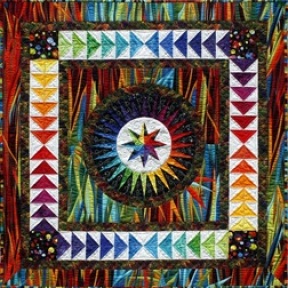I make frequent trips to the Southwest, and you KNOW they include visits to quilt shops along the way. For years I’ve been seeing Southwestern-themed patterns by J. Michelle Watts, who seems to have that niche all to herself. So this last time I thought I’d ask her for an interview. Here she is:
Tell us about your quilts and your other projects, too.
When I started quilting in 1982, I hand pieced and hand quilted mostly traditional quilt blocks.
I designed my first original southwestern wall hanging, Adobe Sunrise, in 1987. In 1989, I started a small mail order pattern company with my own collection of southwestern quilt patterns. I have also designed a line of patterns that use the 9 degree wedge ruler and a couple of jelly roll friendly scrap quilt patterns, written 3 books, and designed 3 collections of fabric for Moda.
“Stenciling Quilt Blocks” is my favorite class to teach right now. The technique is simple, fast and fun and the finished projects can fool you into thinking they are pieced or appliqued.
The black designs in “Pueblo Rhapsody” have been stenciled onto 40 odd shaped turquoise blocks and then the blocks are sewn together. My newest pattern collection, “It’s Simple With Stencils”, is a collection of quilt patterns that use laser cut stencils and Paintstiks to stencil quilt blocks and quilts. The collection features a variety of small traditional quilt blocks and some with a southwestern style.
Inquiring minds always want to know: do you have a “day job”, or do you teach and develop patterns full time?
I print and package all my own patterns. This is my day job, night job and weekend job. I now travel about 120 days a year teaching and vending at quilt shows. I manage a website that features all my patterns. I host a small quilt retreat each year near Ruidoso, NM. This year I want to try to make some short tutorials on several techniques I teach. When people ask me “So what do you do for a living?”, I love being able to tell them ” I am a quilter.” There is a quilted wall hanging in my studio that says “Love what you do and do what you love.” That pretty much says it all.

Casa Blanca, Michelle’s newest applique pattern. Thank goodness it will be available as a stencil, also!
What’s next?
My newest applique pattern, Casa Blanca, which is inspired by an old ironwork door. This design will also be available as a stencil pattern. The dark wine pieces are machine appliqued to a cream background. I have many other patterns in the works as well.
If you want to see all Michelle’s patterns, visit her website. Here are a few of my favorites:
.



































